TOYOTA AVALON HYBRID 2019 Owners Manual (in English)
Manufacturer: TOYOTA, Model Year: 2019, Model line: AVALON HYBRID, Model: TOYOTA AVALON HYBRID 2019Pages: 556, PDF Size: 9.73 MB
Page 481 of 556
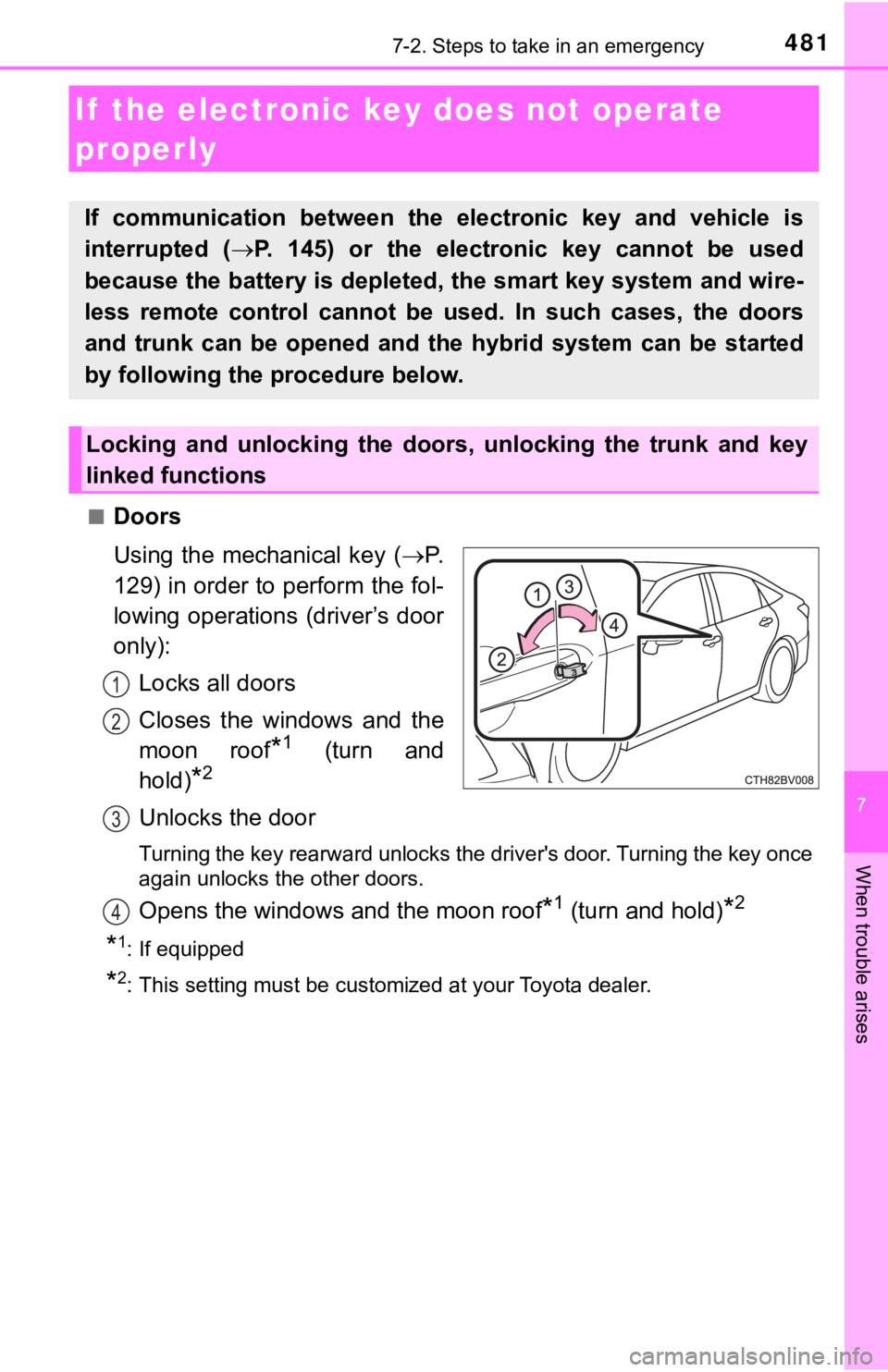
4817-2. Steps to take in an emergency
7
When trouble arises
■Doors
Using the mechanical key (P.
129) in order to perform the fol-
lowing operations (driver’s door
only):
Locks all doors
Closes the windows and the
moon roof
*1 (turn and
hold)
*2
Unlocks the door
Turning the key rearward unlocks the driver's door. Turning the key once
again unlocks the other doors.
Opens the windows and the moon roof*1 (turn and hold)*2
*1: If equipped
*2: This setting must be customized at your Toyota dealer.
If the electronic ke y does not operate
properly
If communication between the electronic key and vehicle is
interrupted ( P. 145) or the electronic key cannot be used
because the battery is depleted, the smart key system and wire-
less remote control cannot be used. In such cases, the doors
and trunk can be opened and the hybrid system can be started
by following the procedure below.
Locking and unlocking the doors, unlocking the trunk and key
linked functions
1
2
3
4
Page 482 of 556
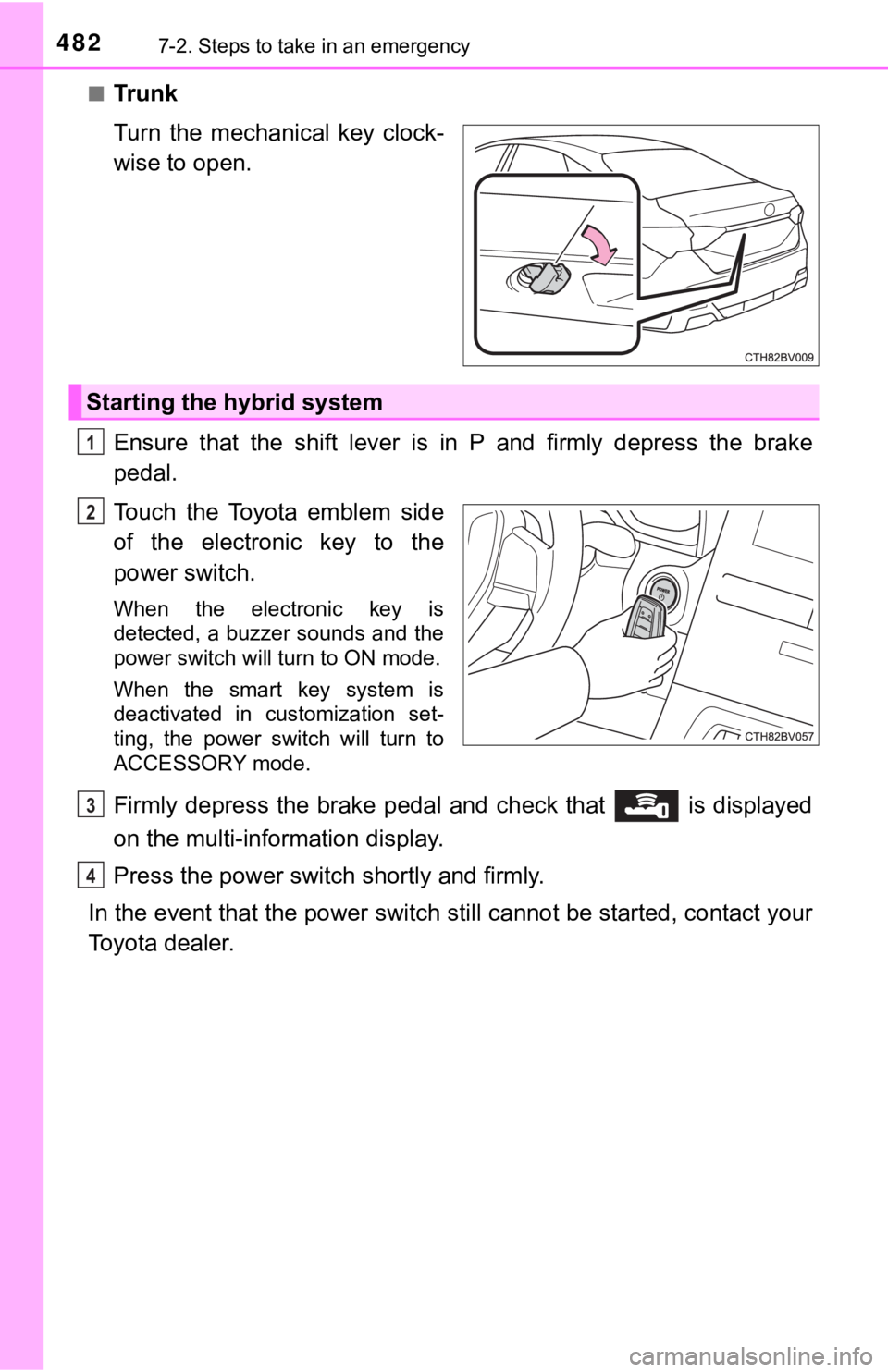
4827-2. Steps to take in an emergency
■Tr u n k
Turn the mechanical key clock-
wise to open.
Ensure that the shift lever is in P and firmly depress the brake
pedal.
Touch the Toyota emblem side
of the electronic key to the
power switch.
When the electronic key is
detected, a buzzer sounds and the
power switch will turn to ON mode.
When the smart key system is
deactivated in customization set-
ting, the power switch will turn to
ACCESSORY mode.
Firmly depress the brake pedal and check that is displayed
on the multi-information display.
Press the power switc h shortly and firmly.
In the event that the power swi tch still cannot be started, contact your
Toyota dealer.
Starting the hybrid system
1
2
3
4
Page 483 of 556
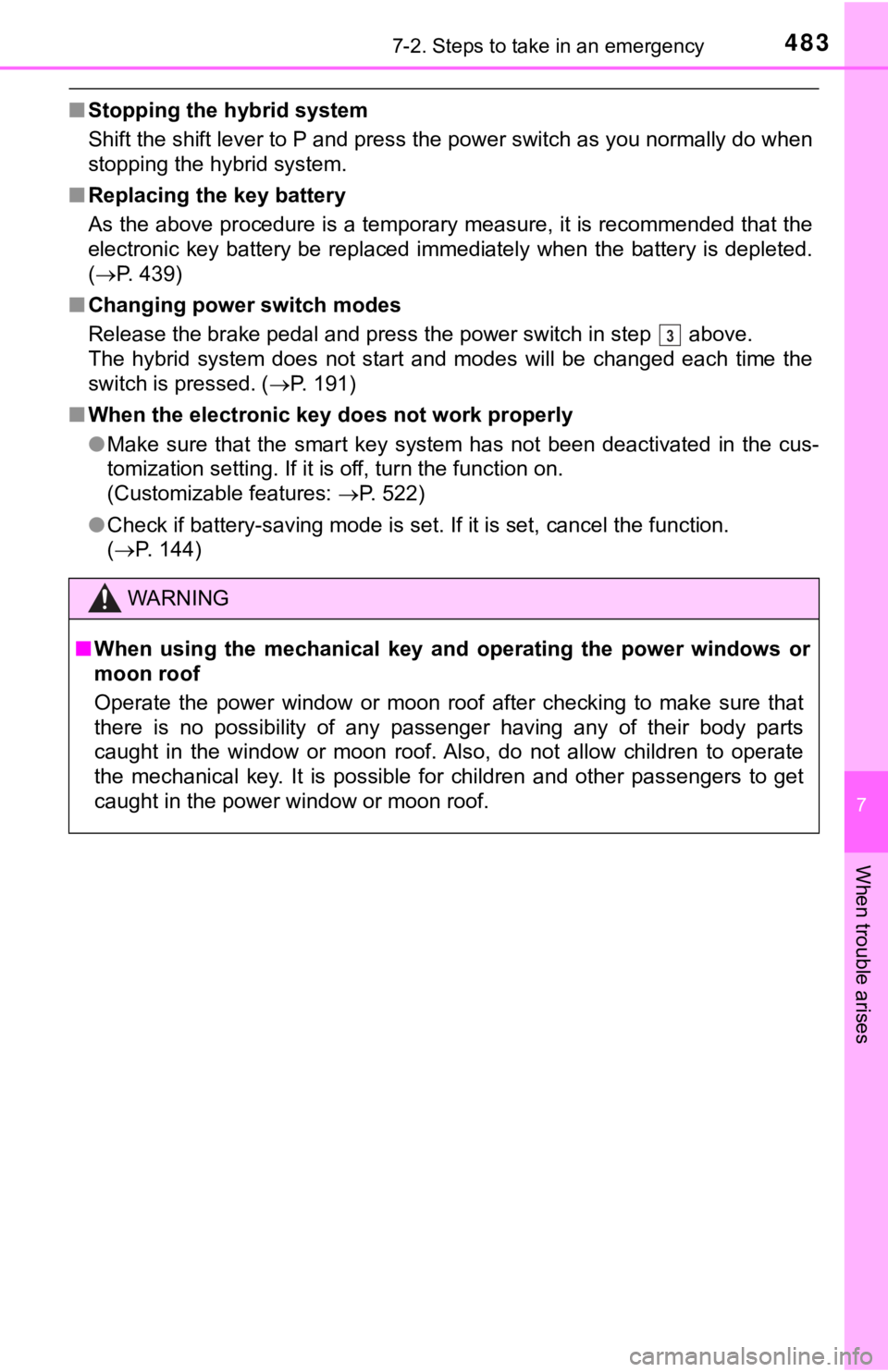
4837-2. Steps to take in an emergency
7
When trouble arises
■Stopping the hybrid system
Shift the shift lever to P and press the power switch as you no rmally do when
stopping the hybrid system.
■ Replacing the key battery
As the above procedure is a temporary measure, it is recommende d that the
electronic key battery be replaced immediately when the battery is depleted.
( P. 439)
■ Changing power switch modes
Release the brake pedal and press the power switch in step abo ve.
The hybrid system does not start and modes will be changed each time the
switch is pressed. ( P. 191)
■ When the electronic key does not work properly
●Make sure that the smart key system has not been deactivated in the cus-
tomization setting. If it is off, turn the function on.
(Customizable features: P. 522)
● Check if battery-saving mode is set. If it is set, cancel the f unction.
( P. 144)
WARNING
■ When using the mechanical key and operating the power windows o r
moon roof
Operate the power window or moon roof after checking to make su re that
there is no possibility of any passenger having any of their body parts
caught in the window or moon roof. Also, do not allow children to operate
the mechanical key. It is possible for children and other passe ngers to get
caught in the power window or moon roof.
3
Page 484 of 556
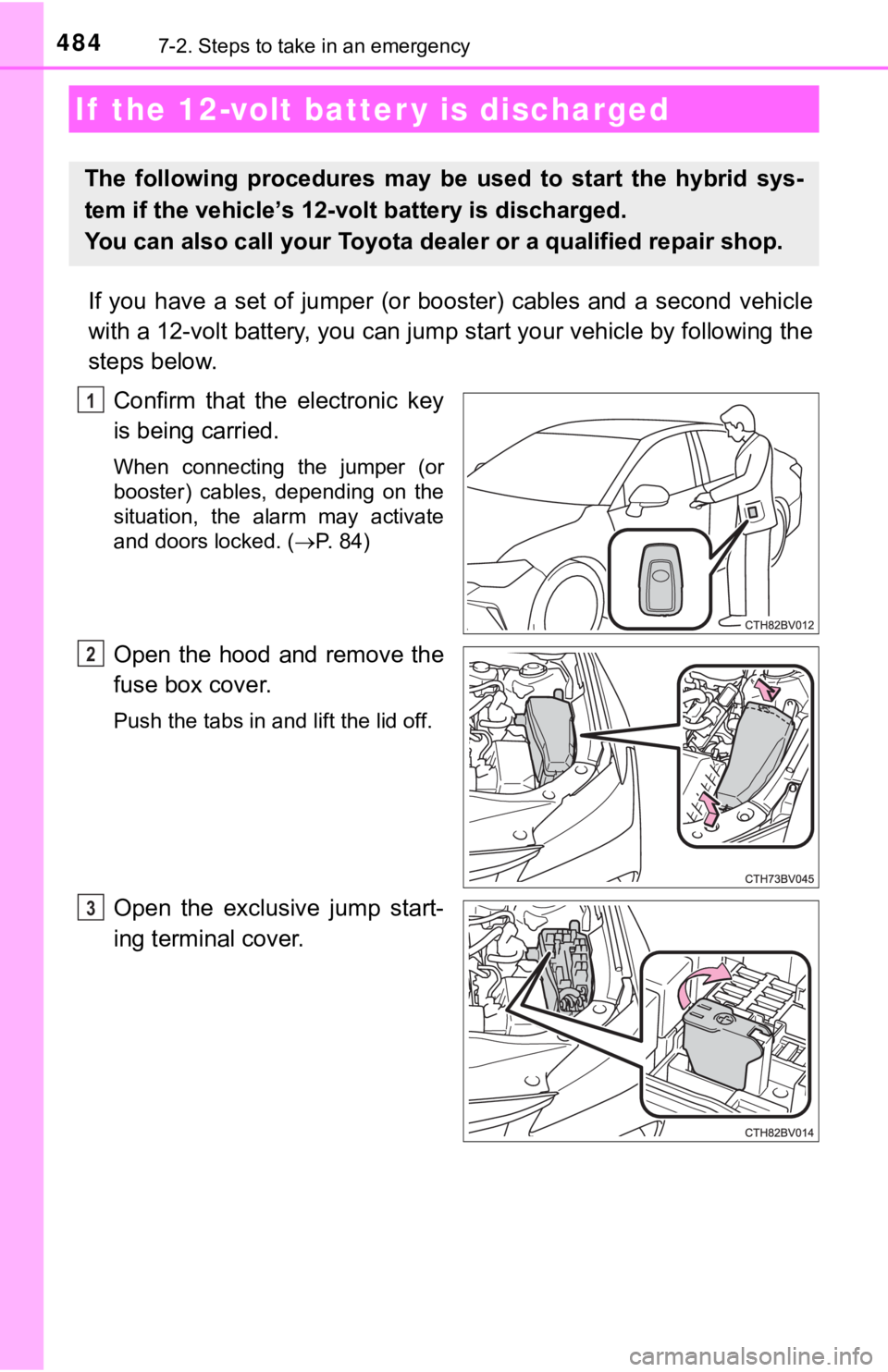
4847-2. Steps to take in an emergency
If you have a set of jumper (or booster) cables and a second vehicle
with a 12-volt battery, you can jump start your vehicle by foll owing the
steps below.
Confirm that the electronic key
is being carried.
When connecting the jumper (or
booster) cables, depending on the
situation, the alarm may activate
and doors locked. ( P. 84)
Open the hood and remove the
fuse box cover.
Push the tabs in and lift the lid off.
Open the exclusive jump start-
ing terminal cover.
If the 12-volt batter y is discharged
The following procedures may be used to start the hybrid sys-
tem if the vehicle’s 12-volt battery is discharged.
You can also call your Toyota de aler or a qualified repair shop.
1
2
3
Page 485 of 556
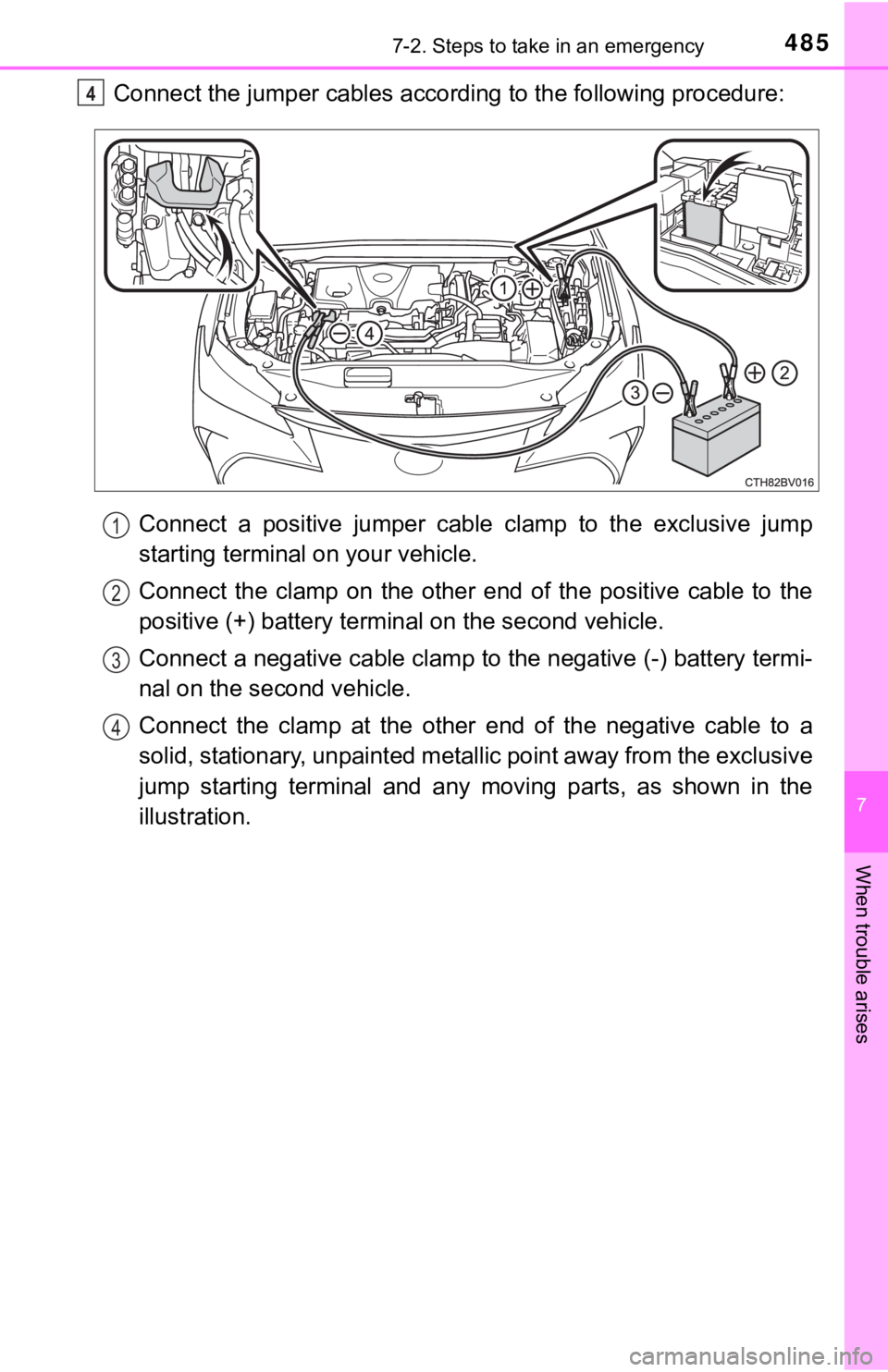
4857-2. Steps to take in an emergency
7
When trouble arises
Connect the jumper cables according to the following procedure:Connect a positive jumper cable clamp to the exclusive jump
starting terminal on your vehicle.
Connect the clamp on the other end of the positive cable to the
positive (+) battery termi nal on the second vehicle.
Connect a negative cable clamp to the negative (-) battery term i-
nal on the s econd vehicle.
Connect the clamp at the other e nd of the negative cable to a
solid, stationary, unpainted meta llic point away from the exclusive
jump starting terminal and any moving parts, as shown in the
illustration.4
1
2
3
4
Page 486 of 556

4867-2. Steps to take in an emergency
Start the engine of the second vehicle. Increase the engine speed
slightly and maintain at that lev el for approximately 5 minutes to
recharge the 12-volt battery of your vehicle.
Open and close any of the doors of your vehicle with the power
switch off.
Maintain the engine speed of the second vehicle and turn the po wer
switch to ON mode, then st art the vehicle's engine.
Make sure the “READY” indicator comes on. If the indicator does
not come on, contact your Toyota dealer.
Once the hybrid system has started, remove the jumper cables in
the exact reverse order from which they were connected.
Close the exclusive jump starting terminal cover, and reinstall the
fuse box cover to it s original position.
Once the hybrid system starts, have the vehicle inspected at yo ur
Toyota dealer as soon as possible.5
6
7
8
9
10
Page 487 of 556

4877-2. Steps to take in an emergency
7
When trouble arises
■Starting the hybrid system when the 12-volt battery is discharg ed
The hybrid system cannot be started by push-starting.
■ To prevent 12-volt battery discharge
●Turn off the headlights and the audio system while the hybrid s ystem is off.
● Turn off any unnecessary electrical components when the vehicle is running
at a low speed for an extended period, such as in heavy traffic .
■ When the 12-volt battery is removed or discharged
● Information stored in the ECU is cleared. When the 12-volt batt ery is
depleted, have the vehicle inspected at your Toyota dealer.
● Some systems may require initialization. ( P. 531)
■ When removing the 12-vo lt battery terminals
When the 12-volt battery terminals are removed, the information stored in the
ECU is cleared. Before removing the 12-volt battery terminals, contact your
Toyota dealer.
■ Charging the 12-volt battery
The electricity stored in the 12-volt battery will discharge gr adually even when
the vehicle is not in use, due to natural discharge and the dra ining effects of
certain electrical appliances. If the vehicle is left for a lon g time, the 12-volt
battery may discharge, and the hybrid system may be unable to start. (The
12-volt battery recharges automatically while the hybrid system is operating.)
■ When recharging or replacing the 12-volt battery
●In some cases, it may not be possible to unlock the doors using the smart
key system when the 12-volt battery is discharged. Use the wire less remote
control or the mechanical key to lock or unlock the doors.
● The hybrid system may not start on the first attempt after the 12-volt battery
has recharged but will start normally after the second attempt. This is not a
malfunction.
● The power switch mode is memorized by the vehicle. When the 12- volt bat-
tery is reconnected, the system will return to the mode it was in before the
12-volt battery was discharged. Before disconnecting the 12-volt battery,
turn the power switch off.
If you are unsure what mode the power switch was in before the 12-volt bat-
tery discharged, be especially careful when reconnecting the 12 -volt battery.
Page 488 of 556
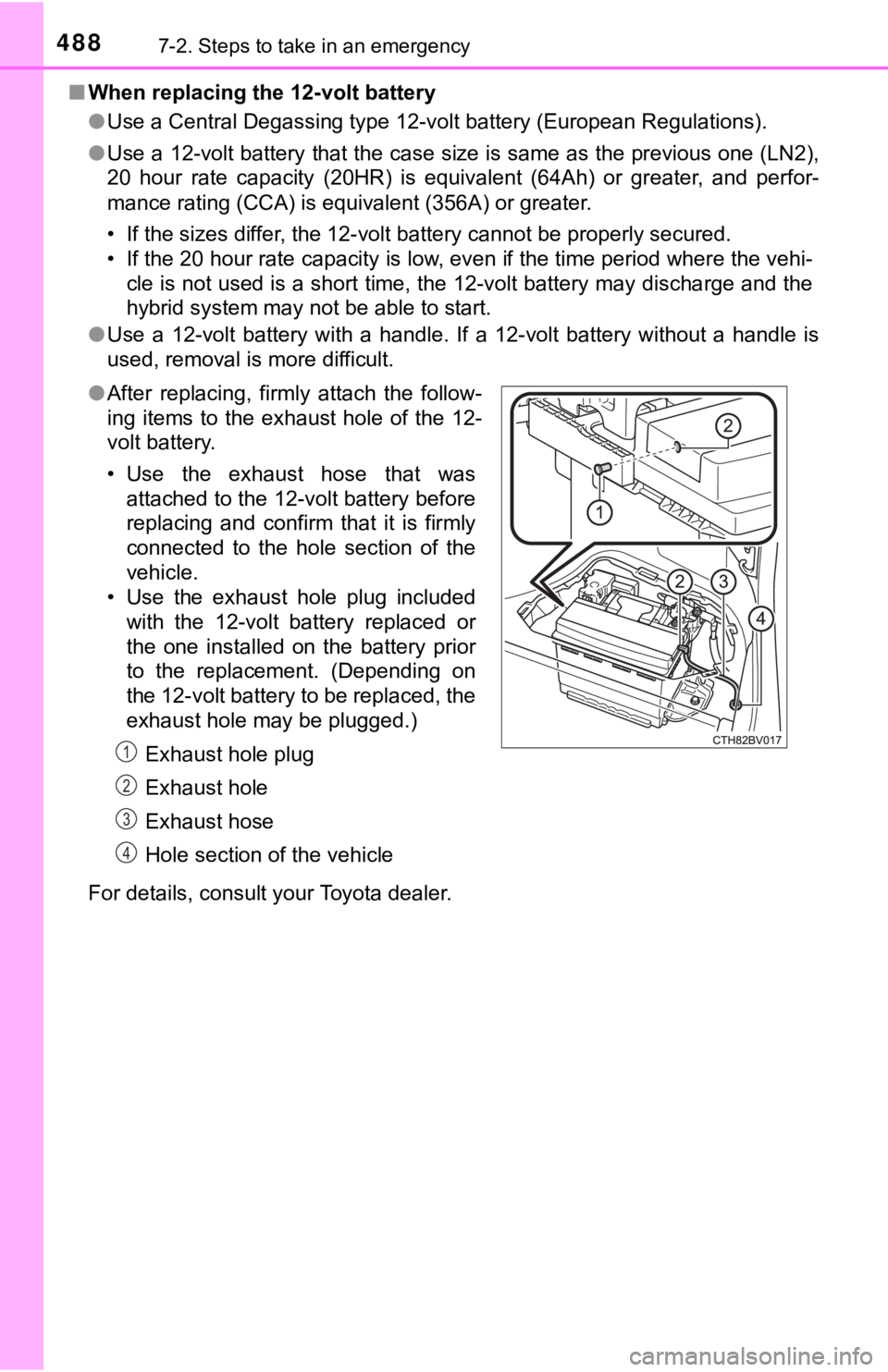
4887-2. Steps to take in an emergency
■When replacing the 12-volt battery
●Use a Central Degassing type 12-volt battery (European Regulati ons).
● Use a 12-volt battery that the case size is same as the previou s one (LN2),
20 hour rate capacity (20HR) is equivalent (64Ah) or greater, and perfor-
mance rating (CCA) is equivalent (356A) or greater.
• If the sizes differ, the 12-volt battery cannot be properly se cured.
• If the 20 hour rate capacity is low, even if the time period w here the vehi-
cle is not used is a short time, the 12-volt battery may discha rge and the
hybrid system may not be able to start.
● Use a 12-volt battery with a handle. If a 12-volt battery witho ut a handle is
used, removal is more difficult.
For details, consult your Toyota dealer. ● After replacing, firmly attach the follow-
ing items to the exhaust hole of the 12-
volt battery.
• Use the exhaust hose that was
attached to the 12-volt battery before
replacing and confirm that it is firmly
connected to the hole section of the
vehicle.
• Use the exhaust hole plug included with the 12-volt battery replaced or
the one installed on the battery prior
to the replacement. (Depending on
the 12-volt battery to be replaced, the
exhaust hole may be plugged.)
Exhaust hole plug
Exhaust hole
Exhaust hose
Hole section of the vehicle
1
2
3
4
Page 489 of 556
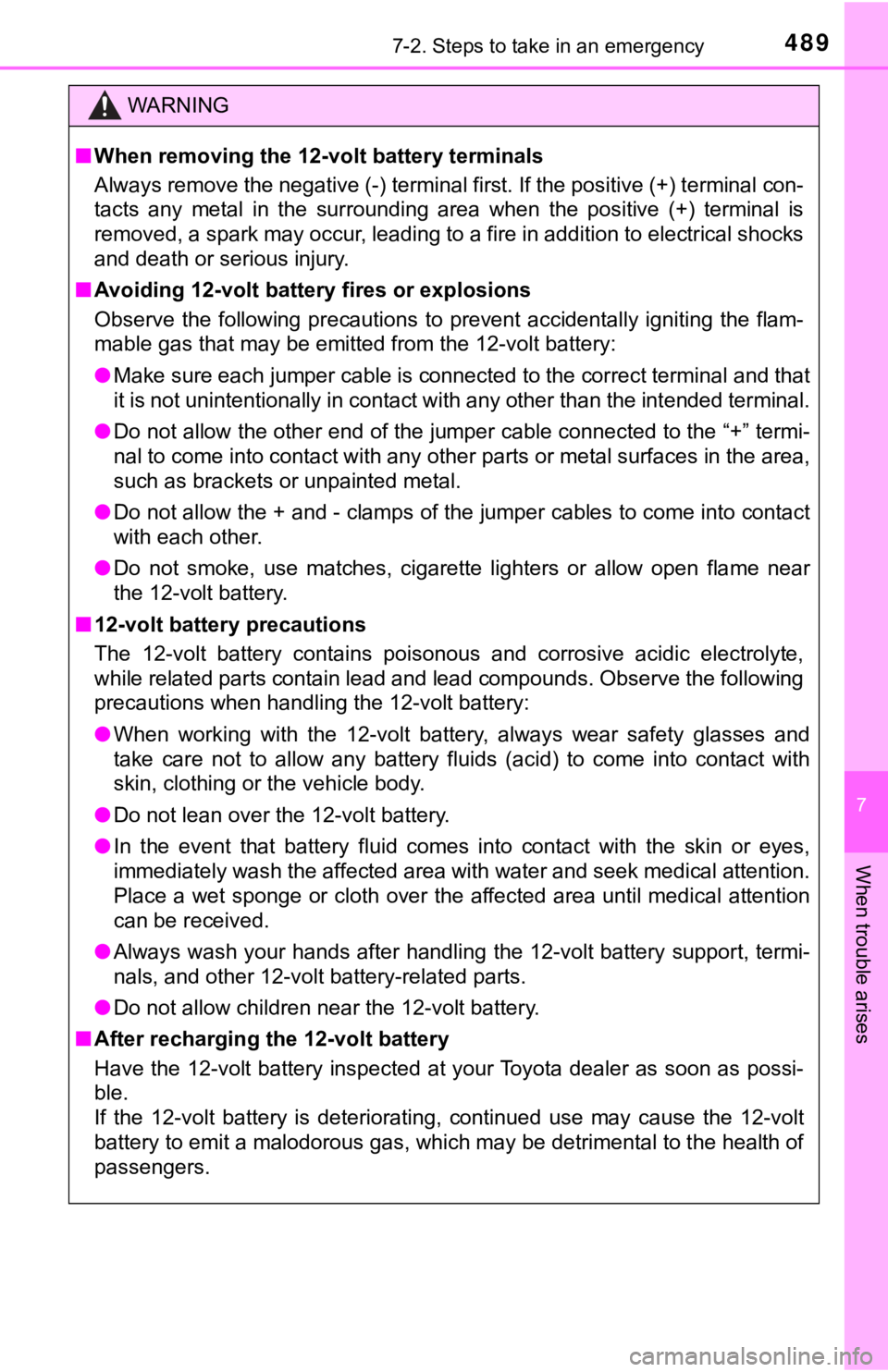
4897-2. Steps to take in an emergency
7
When trouble arises
WARNING
■When removing the 12-vo lt battery terminals
Always remove the negative (-) terminal first. If the positive (+) terminal con-
tacts any metal in the surrounding area when the positive (+) terminal is
removed, a spark may occur, leading to a fire in addition to el ectrical shocks
and death or serious injury.
■ Avoiding 12-volt batte ry fires or explosions
Observe the following precautions to prevent accidentally ignit ing the flam-
mable gas that may be emitted from the 12-volt battery:
● Make sure each jumper cable is connected to the correct terminal and that
it is not unintentionally in contact with any other than the in tended terminal.
● Do not allow the other end of the jumper cable connected to the “+” termi-
nal to come into contact with any other parts or metal surfaces in the area,
such as brackets or unpainted metal.
● Do not allow the + and - clamps of the jumper cables to come into contact
with each other.
● Do not smoke, use matches, cigarette lighters or allow open fla me near
the 12-volt battery.
■ 12-volt battery precautions
The 12-volt battery contains poisonous and corrosive acidic ele ctrolyte,
while related parts contain lead and lead compounds. Observe th e following
precautions when handling the 12-volt battery:
● When working with the 12-volt battery, always wear safety glass es and
take care not to allow any battery fluids (acid) to come into c ontact with
skin, clothing or the vehicle body.
● Do not lean over the 12-volt battery.
● In the event that battery fluid comes into contact with the skin or eyes,
immediately wash the affected area with water and seek medical attention.
Place a wet sponge or cloth over the affected area until medica l attention
can be received.
● Always wash your hands after handling the 12-volt battery support, termi-
nals, and other 12-volt battery-related parts.
● Do not allow children near the 12-volt battery.
■ After recharging the 12-volt battery
Have the 12-volt battery inspected at your Toyota dealer as soon as possi-
ble.
If the 12-volt battery is deteriorating, continued use may caus e the 12-volt
battery to emit a malodorous gas, which may be detrimental to the health of
passengers.
Page 490 of 556
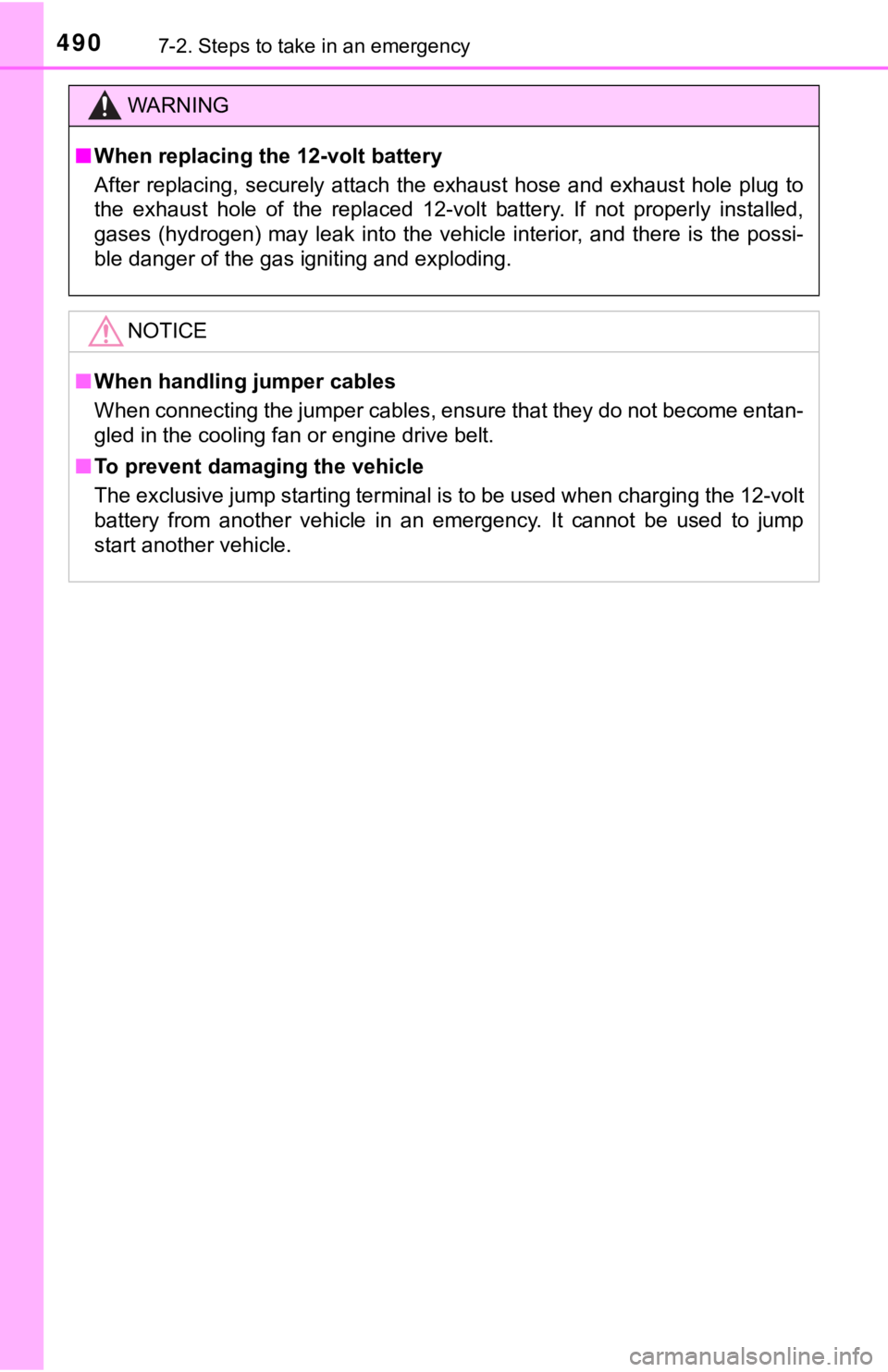
4907-2. Steps to take in an emergency
WARNING
■When replacing the 12-volt battery
After replacing, securely attach the exhaust hose and exhaust h ole plug to
the exhaust hole of the replaced 12-volt battery. If not proper ly installed,
gases (hydrogen) may leak into the vehicle interior, and there is the possi-
ble danger of the gas igniting and exploding.
NOTICE
■ When handling jumper cables
When connecting the jumper cables, ensure that they do not beco me entan-
gled in the cooling fan or engine drive belt.
■ To prevent damaging the vehicle
The exclusive jump starting terminal is to be used when chargin g the 12-volt
battery from another vehicle in an emergency. It cannot be used to jump
start another vehicle.